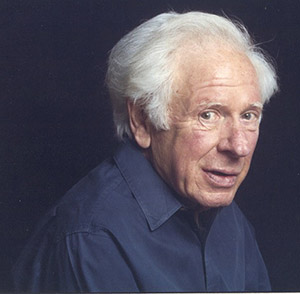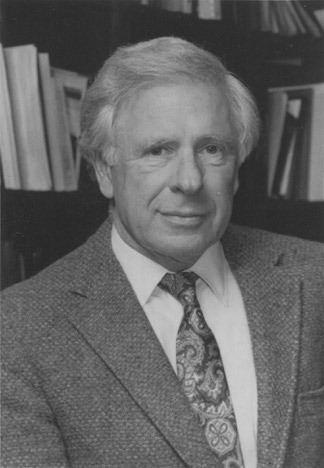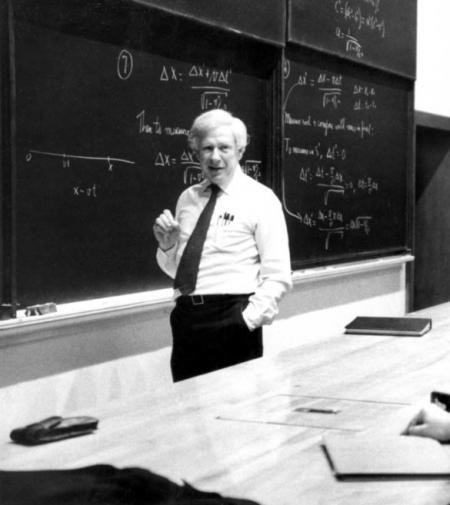
By:
- Kim McDonald
Published Date
By:
- Kim McDonald
Share This:
Prominent UC San Diego Physicist and Dean Dies at 92

Marvin L. "Murph" Goldberger
Marvin L. "Murph" Goldberger, an emeritus professor of physics who was dean of UC San Diego’s Division of Natural Sciences from 1994 to 1999, following a prominent career that included working on the Manhattan Project and serving as the president of Caltech, died Nov. 26 in La Jolla. He was 92.
Goldberger was one of the youngest physicists to work on the Manhattan Project, the program to develop the atomic bomb at the University of Chicago. As a graduate student there, he conducted research under famed physicists Enrico Fermi and Edward Teller, receiving his doctorate in physics in 1948. He was a faculty member at Chicago for seven years, starting in 1950, before moving to Princeton University, where he remained for two decades until 1978, when he was appointed the fifth president of Caltech.
Goldberger’s interest in arms-control issues during his early years at Princeton led him to assist in the formation of an elite group of scientists in 1959, known as JASON, which provided scientific advice to the Pentagon on nuclear weapons and other defense technologies. He was the group’s first chairman and served in that capacity for six years. He returned to Princeton, New Jersey in 1987 to assume the directorship of the Institute for Advanced Study in Princeton and in 1991 returned to California to become a professor of physics at UCLA, where he remained until arriving in La Jolla in 1993.

Frequently sought after on the UC San Diego campus for his sage advice on issues ranging from academe to science policy, Goldberger—who was appointed a professor of physics at UC San Diego in 1993 and retired in 1999 as an emeritus professor—often returned to campus after his retirement to have lunch with faculty, many of whom had become long-time friends.
“We were really lucky to recruit Murph to UC San Diego,” said former Chancellor Robert C. Dynes, president of the University of California from 2003 to 2008, and a close colleague of Goldberger’s in the physics department. “He brought a remarkable breadth of physics and experience to us and to me personally for which I am forever grateful. When we began a search for a dean of the Division of Natural Sciences, I was even more grateful that he accepted the offer. I and the campus as a whole were richer from his presence here at UC San Diego.”
“He had superb people skills,” said Mark Thiemens, a professor of chemistry and biochemistry and dean of the Division of Physical Sciences who was appointed dean of the Division of Natural Sciences in 1999 when Goldberger retired. (In July, 2000, the Division of Natural Sciences administratively split into two separate divisions, Physical and Biological Sciences). “One of the perks of knowing Murph was getting to hear the fascinating stories he had from his life as a world-renowned physicist, science leader and president of Caltech. Murph personally knew and interacted with many of the greatest physicists of the 20th century, and some of the most interesting, such as J.R. Oppenheimer. He served as adviser to a number of U.S. Presidents, and guided U.S. science policy during the critical years after Sputnik, when federal science agencies like the National Science Foundation and NASA, were created.”
Golberger’s influence extended beyond scientific circles, and he was sometimes contacted for advice by media giants such as Arthur Ochs Sulzberger, publisher of the New York Times, and Hollywood stars such as Barbara Streisand, Warren Beatty and Sidney Poitier, with whom he became friends during his years at Caltech. Said Thiemens, “It was always a treat for me to get to visit and spend time with him over the past 20 years.”

In his early years of research as a particle physicist, Goldberger derived, with theoretical physicist Sam Bard Treiman, the so-called “Goldberger-Treiman relation,” which provides a quantitative connection between the strong and weak interaction properties of the proton and neutron.
He was the recipient of numerous awards and academic honors, including the Dannie Heineman Prize for Mathematical Physics, the Presidential Award of the New York Academy of Sciences, the Leonard I. Beerman Peace and Justice Award and honorary degrees from Carnegie Mellon, the University of Notre Dame, Hebrew Union College, the University of Judaism and Occidental College. Goldberger was a member of the National Academy of Sciences, the American Physical Society, the American Association for the Advancement of Science, the American Academy of Arts and Sciences and the American Philosophical Society. He also served as co-chairman of the National Research Council and was a member of the Council on Foreign Relations, the Institute on Global Conflict and Cooperation International Advisory Board and the President's Science Advisory Committee.
Goldberger’s wife, Mildred, whom he met while both were at the University of Chicago working on the Manhattan Project, died in 2006. He is survived by his sons, Joel and Sam, and three granddaughters, Nicole, Natalie and Natasha. A memorial service for friends and colleagues on the campus is being planned and will be announced soon.
See more about Goldberger’s life and work at Caltech
Share This:
You May Also Like
Stay in the Know
Keep up with all the latest from UC San Diego. Subscribe to the newsletter today.


